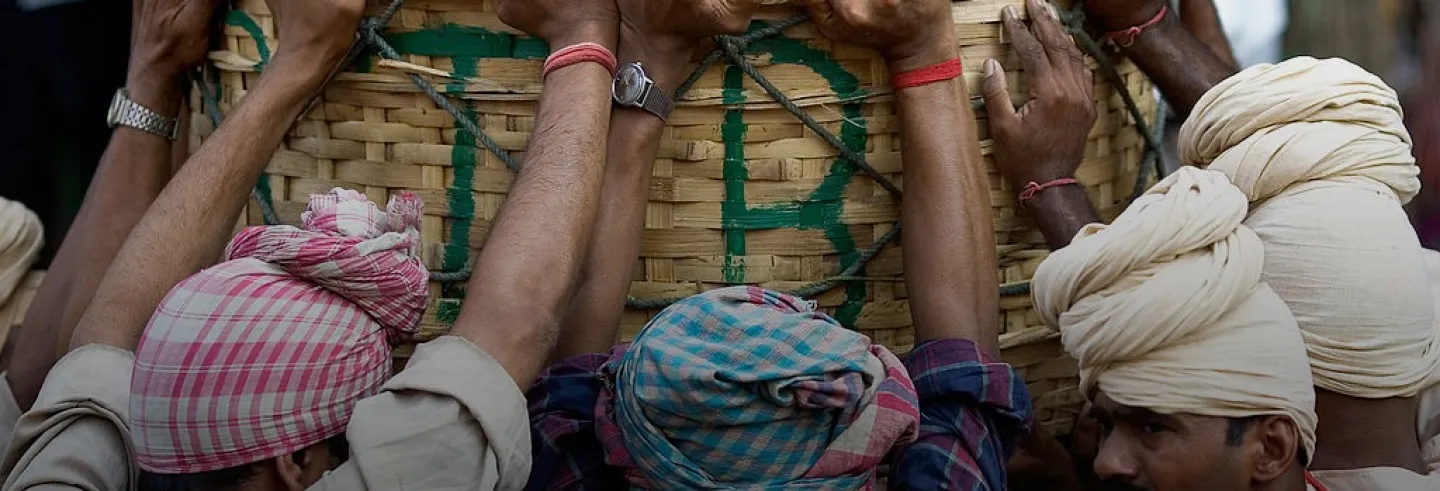Since 2016, India has been promoting formalisation of the economy. Prime examples of official efforts in this direction include demonetisation, introduction of the Goods and Services Tax (GST), digitalisation of financial transactions and enrolment of informal sector workers on numerous government internet portals. Flagging monthly administrative Employees Provident Fund (EPF) enrolment data as the official metric for job creation sent out a clear signal as illustrated in the Economic Survey 2017-18. 1 The Survey, using GST and EPF registrations, claimed, “These estimates for formal non-farm payroll, ranging from 31 percent in the case of social security-defined formality and 53 percent in the case of tax-defined formality, are considerably greater than current beliefs about the size of formal sector non-farm payroll." (Economic Survey, 2017-18, page 42)
A recent SBI report claims that during the first year of the pandemic (2020-21), the informal sector's share in GDP shrank to 'at max 15% to 20% ’—a figure comparable to developed economies—from about 50% until just two years earlier. The report claimed that the government's initiatives since 2016 had turned an unprecedented number of informal workers into members of the formal sector.
This finding has confounded economic analysts and ordinary people alike. How could the informal or unorganised sector's share in employment and GDP shrink sharply (by over 30 percentage points in the case of the latter) in just two years, when the ratios had remained unchanged for decades? Does this formalisation represent a structural transformation or is it simply a harsh, pandemic-induced economic contraction? This article explains the theory, definitions and evidence on formalisation, and examines the claims of the SBI report.
1. Theory and policy perspectives
While theorising conditions in a labour surplus economy, Arthur Lewis (1954) visualised such an economy as consisting of two distinct sectors—the traditional and the modern—each with varying endowments and operating under different behavioural principles.
The successful Asian economies of the 20th century broadly followed the Lewisian growth path. Rapid state-led industrialisation pulled-in surplus labour from the traditional (or mostly agriculture) sector into the modern sector. However, in the rest of the 'Third World', the development outcomes were different. Despite reasonable economic growth, the modern (formal) non-agricultural sector failed to provide adequate productive employment opportunities for the surplus labour that was engaged in the traditional sector. Consequently, the labour market got differentiated and layered with a large informal (unorganised) sector coexisting with the formal (organised) sector even in the non-agricultural sector. As the labour force grew rapidly, it resulted in rising (open and disguised) unemployment in urban areas amidst poverty and squalor. The continued coexistence of the two Lewisian sectors is seen as a more or less permanent feature of developing countries (See Debraj Ray (1998) Chapter 10 for a lucid description of the informal sector).
However, with the emergence of a market-friendly approach as the sole route to development, the persistence of informality is increasingly seen as a consequence of policy-induced rigidities and the principal constraint on growth. According to one strand of thought, well-functioning markets with the primacy of the rule of law, and security of property rights coupled with simplification of bureaucratic procedures, are essential ingredients for unleashing informal firms' ‘entrepreneurial energy ' for economic growth' (De Soto, 1989). Hence less regulation of enterprises and labour, it is contended, would reduce informality.
In another strand of thought, with the haphazard proliferation of markets in Eastern Europe after the collapse of the socialist-style economies, the informal sector became associated with illegal activities and unaccounted (black) economy. By implication, it came to be believed that with better-functioning markets and a sound rule of law, the informal sector would disappear with the rising productivity of the formal sector. (See Giovanni Cornia (2020), Chapter 8 for an exposition of various ideas on informality.)
2. Global definitions
2.1 Labour market perspective
The International Labour Organization (ILO) provides a global template for defining informality. In this template, the informal sector consists of all private unincorporated enterprises owned by individuals or households that are not separate legal entities and for whom no complete accounts are available. Informal employment is a much broader concept that includes not just persons working in informal enterprises, but also includes certain types of employment outside informal enterprises (Figure 1). For instance, persons working in formal enterprises who are not covered by social protection at their work are categorised as informal workers. So too, domestic workers, casual day labourers, and family workers who are not covered by social security provided by their employers.

It is important to clarify that these definitional templates are modified by country-specific features in practice. To illustrate, in this template employees are considered to have informal jobs if their employment relationship is, in law or practice, not subject to national labour legislation, income taxation, social protection or entitlement to certain employment benefits such as paid annual or sick leave. In India, on the other hand, according to the Report of the Task Force on Employment Statistics (Ministry of Labour and Employment, 2017), a job that offers access to at least one social security benefit is defined as a formal job.
2.2 Fiscal perspective on formalisation
International financial organisations such as the International Monetary Fund (IMF) and the World Bank, in principle, seem to accept the ILO’s definitions of the informal economy. However, this framework is considered inadequate for measuring the informal sector’s contribution to output market, an issue which assumes significance given that the informal economy comprises “activities that have market value and would add to tax revenue” (IMF, 2020). In a recent official paper, the IMF said, “While the International Labour Organization has developed an analytical definition of the informal economy, an internationally agreed statistical framework for measuring the informal economy has been lacking. Consequently, the informal economy has been defined and estimated based on diverse criteria depending on varying research and policy motivations” (IMF, 2021).
The increasing interest of development financial agencies in the informal economy seems to foreground the fiscal perspective (the IMF stands for, “It is Mostly Fiscal”, to invoke Lawrence Summers’ celebrated quip) of bringing informal enterprises and their production into the fold of the formal sector in order to expand the tax net. In a recent article, the IMF (2020) said:
The high incidence and persistence of informal labor, particularly in emerging market and developing economies, is increasingly recognised as an obstacle to sustainable development. Informal firms do not contribute to the tax base and tend to remain small, with low productivity and limited access to finance. As a result, economic growth in regions or countries with large informal sectors remains below potential. Informal workers are more likely to be poor than workers in the formal sector, both because they lack formal contracts and social protection and because they tend to be less educated… (page 1).
Such a perspective is also evident from documents put out by the development agencies such as in Loayza (2018). The same view seems to inform and inspire India’s recent formalisation attempts, which are discussed later here.
3. Global evidence
Based on a cross-section analysis of high and low-income countries, La Porta and Shleifer (2014) show a clear negative association between per capita income and the share of self-employment in total employment. They use the latter as a metric of informality (Figure 2). On this basis, they argue that as countries develop, the extent of informality decreases. Thus, informality is a defining characteristic of underdevelopment. The authors caution that ‘informality declines, although slowly, with development’.
They also contend that there is segregation between the formal and informal sectors. The informal (traditional) sector consists of subsistence activities, with houeholds eking out a living by intensely working on meagre, low productivity capital with abundant labour that has zero or little opportunity cost. Given the weight of surplus labour, informal sector wages remain close to the subsistence level, with little scope for surplus generation that could be reinvested for raising productivity.

In the fiscal policy inspired literature, the oft-cited reason for the persistence of informality is that formal sector firms bear the burden of paying taxes and adhering to regulations. However, the development literature does not find government taxation and regulations as fundamental for separating the formal and informal economies (although these may contribute to the demarcation). The development literature instead views economic growth as the cure for informality (ibid).
4. Estimating the size of India’s informal economy
4.1 Output
In India's National Accounts Statistics (NAS), the organised or formal sector consists of the entire public sector, private corporate sector, factory manufacturing, and also the educational and medical institutions receiving government grant-in-aid. As these are overlapping institutional categories, the organised sector output remains an approximation. Its share in GDP increased from about 30% in 1980-81 to 52% in 2017-18 (Figure 3). During the same period, GDP grew annually at 6–7 %; the share of agriculture (which is almost entirely in the informal sector) in domestic output declined from about 35.7% in 1980-81 to about 15% by 2017-18.

In the labour market, factory employment is the defining characteristic of the formal sector, that is, those enterprises employing at least 10 workers regularly using power, or 20 workers without using power. Depending on the definitions used, workers employed in the organised sector as in the NAS constitute 10–20 % of total employment. There is a sharp asymmetry in the distribution of employment and output between the formal and informal sectors. This is mainly on account of the capital-intensive nature of production in the organised sector and the burden of disguised unemployment in the informal sector; roughly half of the workers in the latter are self-employed.
4.2. Estimating informality in India: Employment
Using the ILO’s definitions, Table 1 disaggregates employment in the informal sector and the share of informal employment in the formal sector. The informal sector's share of total employment has declined, very sluggishly, from 88.0% in 1999-2000 to 81.1% in 2017-18, mainly on account of the decline in the share of agriculture in total employment. Disappointingly, this decline has been nullified by an increase in the share of informal employment in the formal sector, from 4.2 % to 9.5 %.
Thus, cumulatively informal employment in total employment remained unchanged at over 90% over the close to three decades when India witnessed rapid growth. However, if we consider the shift in the workforce from agriculture to non-agriculture, then employment has shifted mainly to the non-farm unorganised or informal sector in industry and services, perhaps evenly distributed across rural and urban areas.
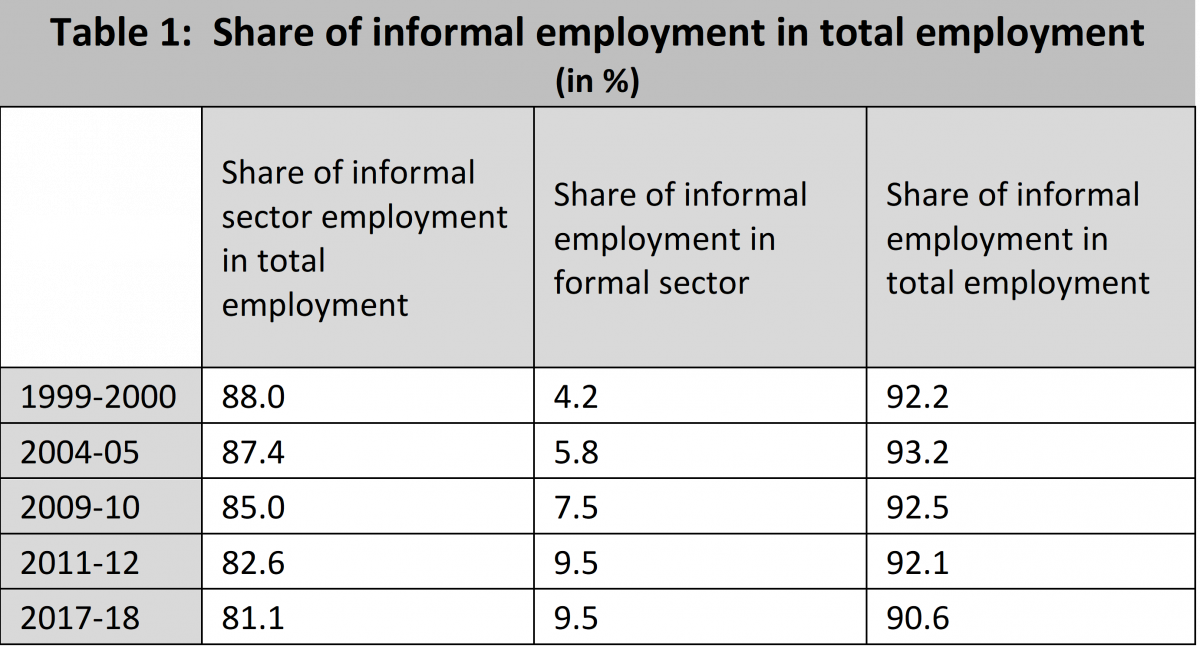
What is the relationship between informality and the level of development in India? There is a positive correlation between the share of regular formal employment (defined as regular salaried workers having access to at least one social security benefit) and per capita Net State Domestic Product (per capita income) among major states (Figure 4(i)). In a mirror image, there exists a negative correlation between the proportion of own account and self-employed workers in total employment and per capita income (Figure 4(ii)). In other words, the richer a state lower the level of informality: rich states have a higher share of formal workers and the poor states have a higher share of informal workers, in total employment. This is similar to La Porta and Shleifer’s association found across countries (Figure 2).

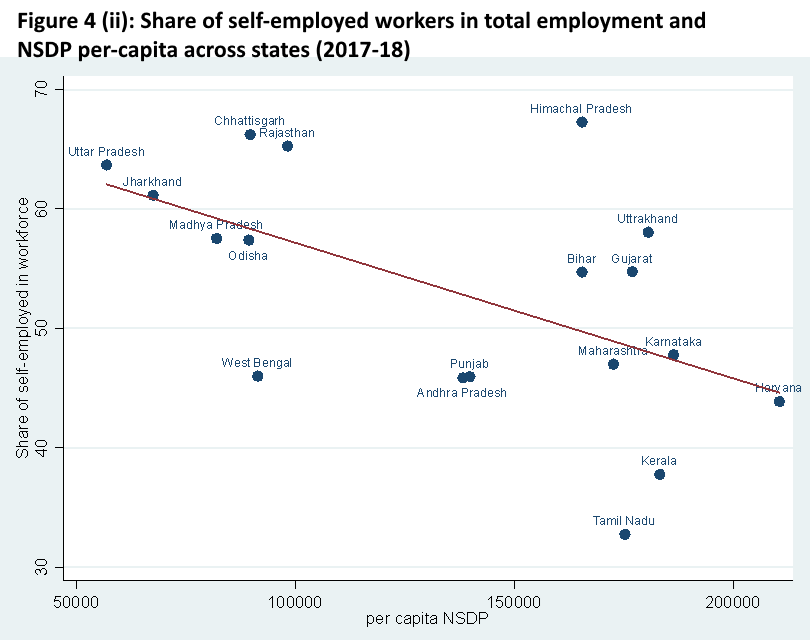
Table 2 describes the dualistic structure of India’s labour market under the ILO’s differentiated framework.
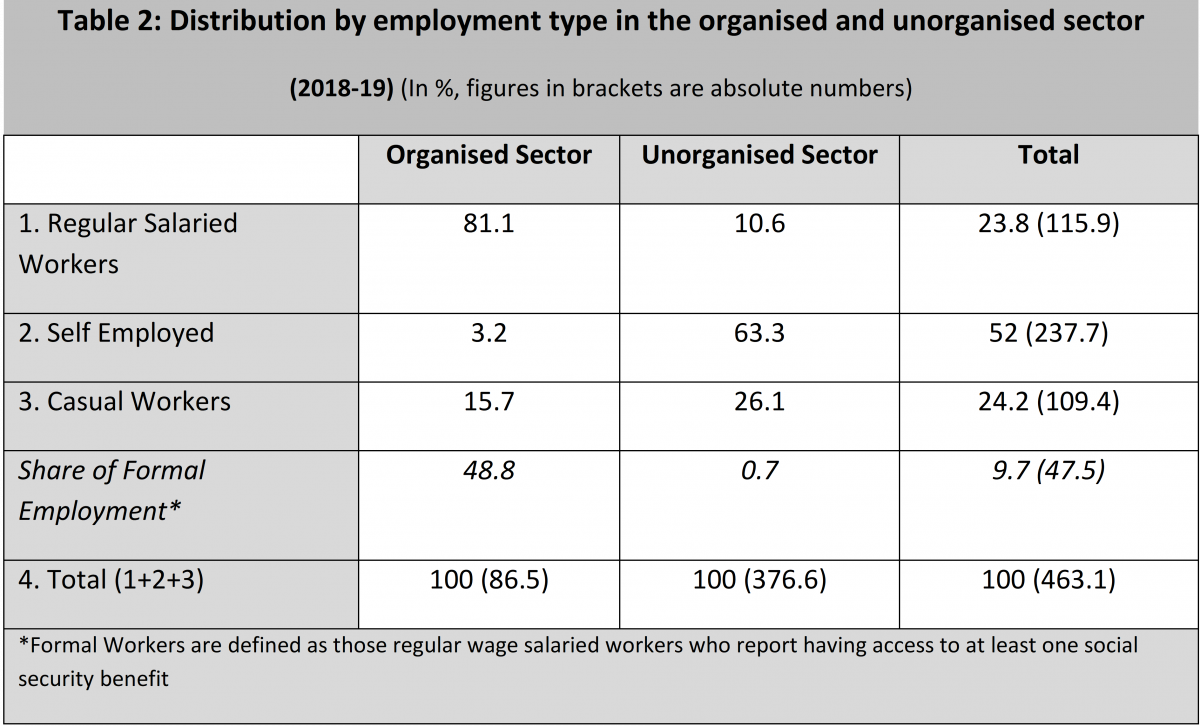
In 2018-19, just about 10% (or 47.5 million) of workers were formally employed, that is, with access to social security. The rest were informally employed. Significantly, even within the formal sector, just about half the workers were in formal employment. Self-employed and casual wage workers accounted for the overwhelming majority (347.1 million or three-fourths of all workers), mostly employed in the informal sector.
Unlike in the Lewis model's undifferentiated low-productivity traditional sector, informality has increasingly become differentiated and multi-layered when seen through the ILO’s lens on the informal sector.
5. The Indian discourse on formalisation
If the evidence on informality and underdevelopment is so compelling, what informs India’s current policy discourse on formalisation? As foregrounded in the IMF's discussion of the formal and informal, it appears to be the dominance of the fiscal perspective.
Early on, to promote employment, Indian policy prioritised labour-intensive industries in consumer goods (called the “cottage industry”). Later, industrial policy expanded its scope to promote sub-contracting by capital goods industries to encourage farming out of labour-intensive activities among small enterprises, to support entrepreneurship and to spur diffusion of industrial skills and technologies.
The cotton textiles industry best exemplifies the government’s efforts and their outcomes. Though modern composite (spinning and weaving) mills dominated the cotton textile industry at the time of Independence, economic planning encouraged handloom weaving by imposing restrictions on expansion of composite mills. Ironically, the policy decimated not only the flourishing composite mills but the handlooms as well. The real winner turned out to be the powerloom sector with access to (more productive) second-hand looms from the organised mills and employing workers at the low wages then prevailing in the handloom sector. A specialised cotton spinning industry boomed with the advantage of scale economies in production to supply yarn to handlooms and powerlooms (Omkar Goswami, 1985).
The spread of labour-intensive industries to the unorganised or informal sector (or parts thereof) got intensified with the spread of electricity, infrastructure (permitting spatial decentralisation), dissemination of skills, tax concessions, and state promotion efforts (Nagaraj, 2015). Large producers and trading firms, however, found an opportunity to procure labour-intensive parts, products and services from the informal sector enterprises. Thus, unlike La Porta and Shleifer’s observation of developing economies, in India formal and informal sector enterprises are increasingly inter-linked via labour and product markets with dense sub-contracting (outsourcing) relationships, going right down to households engaging women and children in the low-income settlements of urban and peri-urban areas. However, it is hard to map, let alone estimate the size and composition of such inter-sectoral transactions. 2 For a recent case study of the supply-chain network of leading national textile brands to garment factories, and on to household enterprises for intricate labour-intensive work in Kolkata garment cluster, see Satyaki Roy’s chapter in Nagaraj (2021).
There is a need to appreciate the enormous heterogeneity in the informal sector..to understand what formalisation really means to such enterprises and for the economy.
Such industries in select locations quite conceivably dodge the tax net, as often contended in the fiscal discourse. They may take advantage of subsidised power (or worse, of power theft), evade taxes and labour and enterprise regulation, generating unaccounted output and income (black money). This view echoes the IMF's sentiment on informality. Sukhamoy Chakravarty (1987), while alluding to the "fiscal crisis of the state", contended that unorganised industries that benefited from state assistance have often failed to comply with tax and labour laws.
Without doubt, such activities need to be brought into official national accounts and taxation net. The reasons for the government's inability to bring them under the tax net or ensure compliance with labour regulation are only partly administrative. Perhaps the larger reasons are the political and economic factors operating at the regional and local levels. Rising democratic decentralisation, via the electoral process, adds to the administrative constraint as many such industries flourish under local political-bureaucratic patronage cutting across party lines, and cleavages of social identity.
If, however, labour and enterprise laws are sought to be enforced, such firms—given their footloose nature—use many ways to circumvent regulations: shift locations (from urban to rural), or reappear under different organisational forms, or reorganise themselves under different legal names (say, into a household enterprise that employs family labour, including using child labour). These are some of the reasons (not necessarily the only or dominant ones) why the share of household manufacturing employment in total manufacturing employment has hovered around 30% for over three to four decades now (Chakbraborty and Nagaraj, 2019). Such a persistence of the household non-agriculture sector seems at variance with industrialisation experience of the advanced economies during their comparable stage of development.
One of the aims of numerous tax reforms since 1985—especially the latest and perhaps most stringent one, the introduction of GST in 2017—has been to bring the enterprises in the informal or unorganised sector into the tax net. However, there is little to show for the outcome. Chakravarty reported a tax-GDP ratio of 18.5 % for 1984-85. Even after three and half decades, the figure remains unsurpassed with the ratio standing at 17.4% of GDP in 2019-20.
It needs to be appreciated that such thriving industries in specific locations may constitute just the tip of the iceberg of the informal sector, especially in terms of employment. What remain hidden are the large swathes of low productive informal establishments working as households and self-employment units that are best described as "petty production”” (to use the category of classical economics). These eke out their subsistence by using surplus labour intensely on meagre capital. Nearly half of the informal sector workers are in “own-account enterprises” or are self-employed, with average earning levels lower than those of regular salaried workers. It would be a misnomer to call them "entrepreneurs". They lack the financial ability and commercial knowledge to take “business risks” and borrow capital and hire labour to produce for the market. Survival is the biggest challenge for such workers and their families, and precarity defines their existence.
[T]he SBI report's assertion of a steep decline in the informal sector's share in GDP by 2020-21 is confounding, or to put it bluntly, near impossible!
Such production units and their workers may operate under the penumbra of illegality and evade taxes. They may lie below the floor for payment of GST, but they may still be evading local regulations such as complying with the Shops and Establishments Acts that are applicable in urban areas. Contrary to the “fiscal view of informality”, such informal enterprises may not pose unfair competition to formal enterprises by non-compliance with formal regulations, non-payment of taxes, and avoidance of other “legal” costs of production. They in fact have to borrow at usurious interest rates in the informal credit market. The earnings of such workers are, on average, are lower than those of regular salaried workers. Often, such own-account workers are too poor or functionally illiterate to be able to even complete the paperwork necessary for legal compliance or pay taxes.
Even if such establishments get formalised (registered under the relevant laws), banks usually do not entertain them, as they often lack mortgageable assets. (The urban poor may not even have permanent addresses given their precarious existence.) Recent initiatives of financial inclusion (Jan-Dhan Yojana) and collateral-free public sector bank lending (the Mudra scheme) can hardly claim to have made a dent on the needs of the urban poor. Such workers and enterprises are likely to survive by doing “job work”, that is, by performing labour-intensive tasks on raw material obtained from a trader or a manufacturer for a pre-specified “labour charge”.
Even among non-household enterprises employing hired labour (seemingly capitalist enterprises), those making profits and investments on a sustained basis are likely to be a tiny fraction. There is thus a need to appreciate the enormous heterogeneity in the informal sector—from relatively high productive industrial clusters such as powerlooms to subsistence household units— to understand what formalisation really means to such enterprises and for the economy. The productivity differentials within the informal sector are presented in Table 3, which reports Gross Value Added (GVA) per enterprise and per worker across both for own-account enterprises (OAEs) and establishments (i.e., enterprises operating with hired labour) in the informal sector. The significant productivity differentials within the sector are apparent.
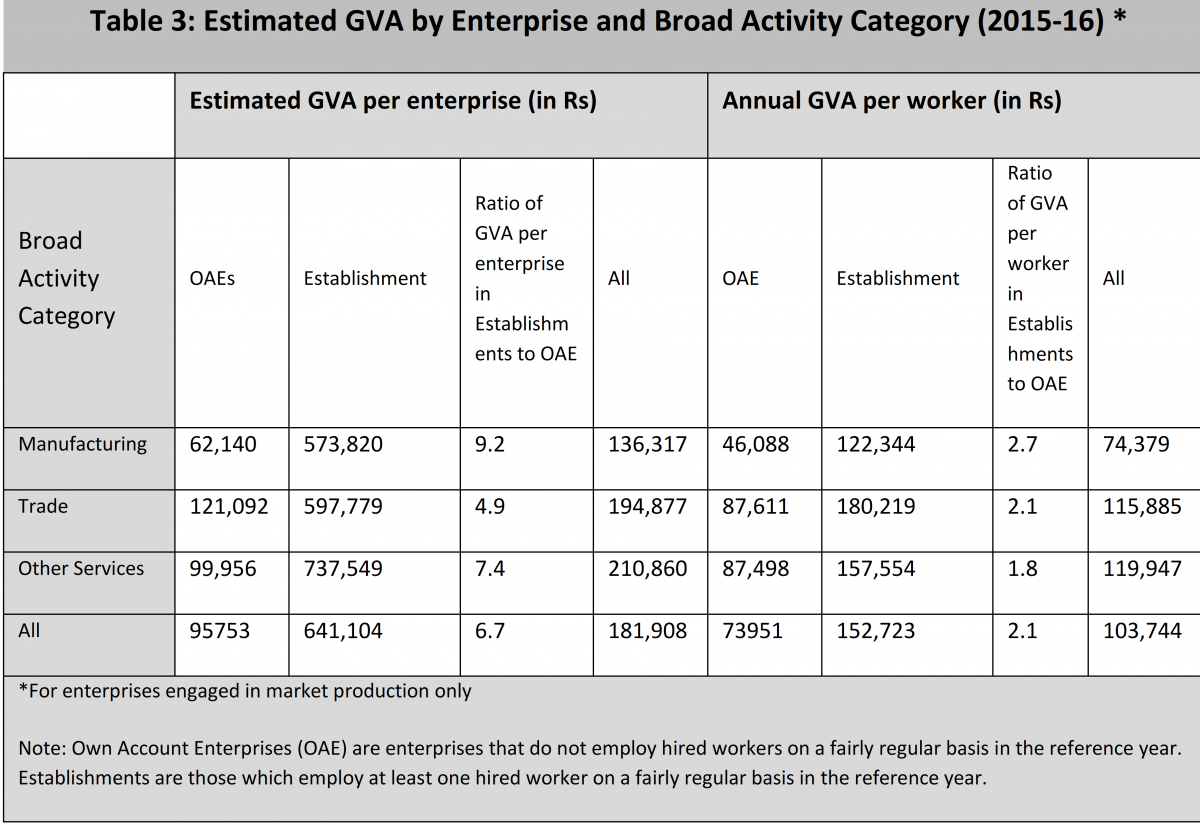
Despite the efforts of government agencies to register informal workers under social security regulations since 2016, the proportion of the workforce receiving benefits remains abysmal. The PLFS shows that in 2018-19, the ratio of the total workforce with access to at least one social security benefit were a mere 9.6%. When more stringent criteria of formal employment are considered (i.e., having access to multiple social security benefits), the share goes down to 4.2% (Kapoor, 2020) and most of them are likely to be public sector workers.
6. The SBI report’s puzzling evidence
The State Bank of India’s research report finds a sharp fall in the informal sector's share in output from 52.4% to 15-20% in the pandemic year of 2020-21. The report notes that while the formal sector is back to pre-pandemic levels, the informal sector has seen considerable output contraction. As the share of the formal sector in GDP has gone up (even as GDP itself has contracted), the report claims there is a successful transformation to formality. The report's estimate of the informal sector's output contraction is factually incorrect, as Bhattacharya (2021) has shown. Table 4 shows the distribution of output by formal and informal sectors for the most recent years. Given that the informal sector's GDP share has hardly declined over the six years (2011-12 to 2017-18), the SBI report's assertion of a steep decline in the informal sector's share in GDP by 2020-21 is confounding, or to put it bluntly, near impossible!

For the labour market, the SBI report credits government efforts at formalising large numbers of informal workers. However, data from the PLFS suggest otherwise. If we examine the distribution of non-agriculture employment across formal and informal enterprises, the share of employment in informal enterprises has gone up from 68.2% to 69.5% between 2017-18 and 2019-20 (Table 5). The increase is particularly noticeable in rural areas. These statistics, coupled with a 3 percentage point increase in the share of employment in the agricultural sector (which as noted earlier is almost entirely informal) between 2018-19 and 2019-20 (not reported here), do not show any evidence of formalisation in the labour market.

Significantly, the SBI definition of formalisation is not access to social security (as officially accepted in India) but mere registration on various online portals. Simply registering workers on online portals without ensuring compliance with social security provisions does not amount to formalisation. As is widely acknowledged, labour codes/laws in India (as in many developing countries), tend to be aspirational with innumerable loopholes and poor implementation.
7. Conclusions
The contraction of the informal sector's output share in India in 2020-21— as noted in the SBI research report—is the unfortunate outcome of the health pandemic and severe lockdowns imposed in 2020 and 2021. The contraction is, however, temporary. It will perforce get reversed in due course as the economy recovers from the health shock. The informal sector will get back to work, to do whatever it can, for sheer survival. The economic contraction hardly represents a virtuous movement of the low productive informal sector or traditional sector workers to the higher productive formal sector on a sustained basis. A mere registration under the myriad official online portals does not amount to a reduction of informality as the enforcement of the underlying labour codes/laws remains poor.
India’s policy of employment promotion has led to diffusion of many labour-intensive industries and activities into the unorganized or informal sector.
Much of the on-going drive for formalisation in India seems anchored in the IMF’s foregrounding of fiscal considerations. The informal sector, under this view, is seen essentially as comprising tax evaders and arbitragers. Incentives to reduce evasion and provide a level-playing field for tax-compliant entities, it is argued, could expand the tax base and increase formality. However, global evidence suggests that the argument that legal and regulatory hurdles restrict formalisation does not hold much water.
India’s policy of employment promotion has led to diffusion of many labour-intensive industries and activities into the unorganized or informal sector. In its zeal to (rightly) net the “creamy layer” (the tip of the iceberg of informal sector industries) into the tax net, government policy seems to fail to appreciate that the bulk of the informal units and their workers are essentially petty producers (self-employed and casual workers) eking their subsistence out of minimal resources. Their continued dominance in the labour market and enterprise landscape is a consequence of underdevelopment and not structural rigidities, as widely perceived. Formalisation will naturally follow when informal enterprises become more productive by capital investment, and the workers by education and skill formation.


